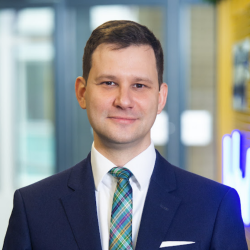Spotlight on Eva Bestelink, co-inventor of the ‘Multi-Modal Transistor’
Eva was an undergraduate student in her second year when she developed the Multi-Modal Transistor alongside a member of staff, Dr Radu Sporea. They disclosed the invention to the TTO and the decision was made to file a patent. In this case, Eva was required to assign her rights in the invention to the University as she was a joint inventor with a member of staff. Eva will gain a share of income made by the University in commercialising this technology.

My inspiration
During my BEng Electronic Engineering at University of Surrey, I had an idea for an electronic device with operation based on neural behaviour. I approached Dr Radu Sporea and in the summer of 2017 we jointly invented the device known as the multimodal transistor (MMT), which has functional benefits beyond what we could have imagined to achieve.
Working with the Technology Transfer Office
Having seen its unique operation and advantages over current thin-film technology, we approached the Technology Transfer Office to see about protecting the IP. As I was an undergraduate student at the time when there was no set IP code for undergraduates, I was required to sign over my IP rights if I wished for Surrey to patent the device. The document I signed was the same one that applies to researchers, as well as postgraduate students with the same royalties and terms. So, essentially, this was straightforward and fair.
The patenting process
While I was deciding about signing my rights to Surrey, the Technology Transfer team was searching the patent database to ensure the MMT was indeed inventive over other devices, as patenting is expensive and the decision cannot be taken lightly. Dr Sporea and I continued to work closely with the Technology Transfer team during this time, gathering as much information on other devices and explaining their operation and the differences to our approach.
The decision was then made by Surrey to patent and I agreed to sign over my rights. However, our responsibilities as inventors were only beginning. Over the next few months we were working closely with the attorney from Venner Shipley LLP to draft the patent. Simultaneously, we had secured funding from Surrey’s Impact Acceleration Account to have MMTs fabricated for proof of operation. Generally, while simulation data is sufficient as long as previously verified benchmarks exist, working prototypes provide irrefutable evidence of operation.
Publishing
In October 2020, we published our measurement and simulation results in Advanced Intelligent Systems. One of the misconceptions people have is that if you patent, you can’t publish. As long as the initial patent has been filed, the only reason to keep the IP secret is if there’s any strategic advantage.
Lessons learned
Looking back, this whole journey started with one crucial step. Trusting Dr Sporea with my idea. Generally, it is advisable to keep any inventions or ideas to yourself, but in some circumstances you might need to share your idea, particularly when it is the only way for it to be acted upon. As long as your IP is inventive and has not been shared in the public domain, it is protectable. I have often given thought to those that have argued that IP should be free for all to use and share. But in my opinion, this still results in companies profiting. The only ones losing out are the inventors and creative thinking should be encouraged and rewarded.
Finally, the support I have received from Dr Sporea, the Advanced Technology Institute, the Technology Transfer team and the Impact Acceleration Account has been remarkable. I have been afforded so many opportunities. I now am engaging with industry as part of the commercialisation process and am learning the true value of a PhD beyond research.

